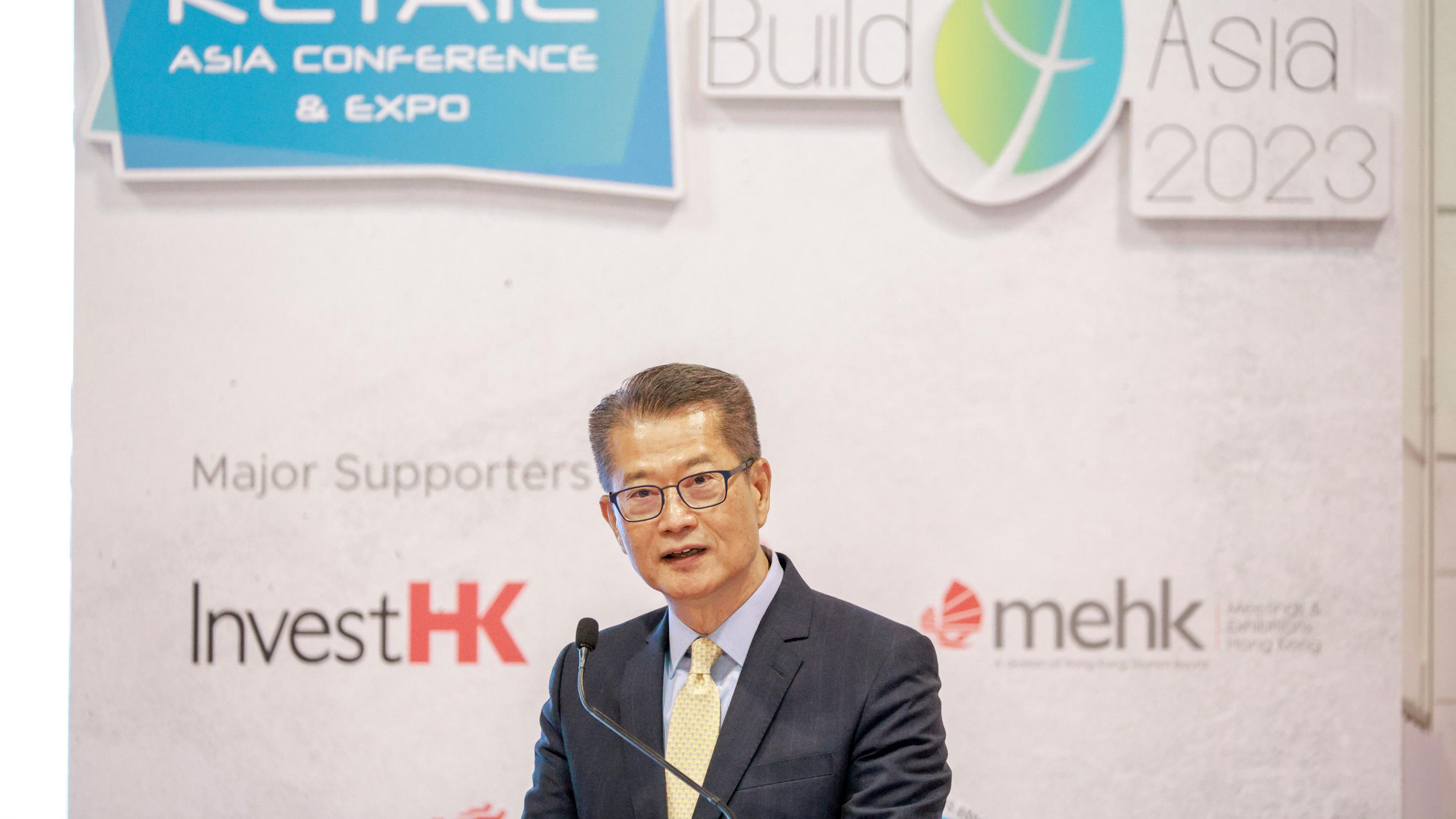 Financial Secretary Paul Chan Mo-po delivers a speech during the opening ceremony of four large international trade fairs: HOFEX2023, ProWine, Retail Asia Conference EXPO, and Build Asia 2023, in the Hong Kong Convention and Exhibition Centre in Wan Chai on May 10, 2023. (ANDY CHONG / CHINA DAILY)
Financial Secretary Paul Chan Mo-po delivers a speech during the opening ceremony of four large international trade fairs: HOFEX2023, ProWine, Retail Asia Conference EXPO, and Build Asia 2023, in the Hong Kong Convention and Exhibition Centre in Wan Chai on May 10, 2023. (ANDY CHONG / CHINA DAILY)
Hong Kong must break the bottleneck in land supply to realize more robust economic growth and generate new development momentum, especially in the Northern Metropolis and on the proposed Kau Yi Chau Artificial Islands, Financial Secretary Paul Chan Mo-po says.
Writing in his Sunday blog, Chan said, “there is a consensus in Hong Kong Special Administrative Region government that inadequate land supply has led to high property prices and is a brake on the economy.”
He added that given the time required for land development and infrastructure construction, as well as possible contingencies that may hinder or delay the progress of projects, Hong Kong must increase its land supply in a multi-channel and diversified way.
“That is why we have always been emphasizing that the development of the Northern Metropolis and the Kau Yi Chau Artificial Islands project must be promoted in top gear,” said Chan.
From a long-term and macro perspective, the city has initially planned a land supply of 7,300 hectares, 54.6 percent of which comes from two strategic growth areas, namely the Northern Metropolis, which is expected to provide over 3,000 hectares of land, and the Kau Yi Chau Artificial Islands project, which is expected to provide 1,000 hectares.
Financial Secretary Paul Chan revealed that the establishment of the Steering Committee on the Northern Metropolis is underway, and a concrete development plan will be proposed within the year. The Development Bureau will soon conduct a new round of public consultation on the San Tin Technopole project, the flagship of the northern region, with the aim of pressing forward with land formation next year
As part of Hong Kong’s new “South-North dual engine” industrial pattern, the Northern Metropolis project will contribute to speeding up the development of Hong Kong as an international innovation and technology hub, and facilitate synergistic cooperation with sister cities in the Guangdong-Hong Kong-Macao Greater Bay Area. The project will provide more than 500,000 new residential units.
ALSO READ: HK lawmakers: Lantau project needs community buy-in
“I have earmarked HK$100 billion ($12.75 billion) in the 2023-24 Budget announced last year with a view to accelerating the housing and transport infrastructure projects in the Northern Metropolis,” said the financial chief.
He revealed that the establishment of the Steering Committee on the Northern Metropolis is underway, and a concrete development plan will be proposed within the year. The Development Bureau will soon conduct a new round of public consultation on the San Tin Technopole project, the flagship of the northern region, with the aim of pressing forward with land formation next year.
Of the nearly 8,000 public respondents in the recently concluded consultation, about 60 percent supported the Kau Yi Chau Artificial Islands project.
“The growing shortage of land supply has far-reaching consequences, as the median of living space per capita in Hong Kong is only 170 square feet (15.8 square meters), one-third less than in Shanghai and Singapore, and 40 percent less than in Shenzhen,” Chan said, stressing that it is urgent for the government to increase land supply through multiple development projects including reclamation.
The Kau Yi Chau Artificial Islands project will provide about 200,000 flats to accommodate 500,000 to 550,000 citizens. According to the government’s planning, the islands will evolve into Hong Kong’s third core business district, providing a total of 5 million square meters of commercial space.
In addition to housing and commercial functions, the project is positioned to connect Hong Kong Island, Lantau Island, Hong Kong International Airport, the Hong Kong-Zhuhai-Macao Bridge and the New Territories West.
READ MORE: Survey: Northern Metropolis development welcomed by public
When the artificial islands are fully developed, related economic activities are expected to bring an annual revenue of about HK$200 billion to the SAR, equivalent to about 7 percent of its GDP.
The latest figures released by the Housing Bureau suggest that some 107,000 first-hand private residential units may be available in the coming three to four years, an increase of 40,000 over the past decade. Residential property prices, however, have shown no sign of falling during this period, and reached a record high in late 2021.
irisli@chinadaliyhk.com
